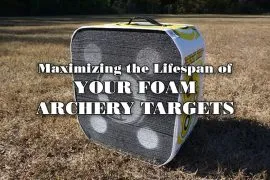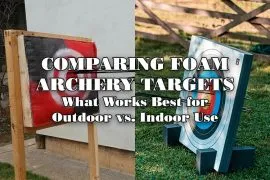The evolution of archery from a historical skill to a modern sport and recreational activity has been significantly influenced by advancements in equipment, particularly foam archery targets. Modern technologies have revolutionized these targets, enhancing durability, sustainability, and user experience. This overview explores these innovations, their benefits, and their impact on casual archers and competitive athletes.
Material Innovations
Table of Contents
High-Density Polyethylene (HDPE) Foam
Description: A leap from traditional foams, HDPE offers exceptional durability and arrow-stopping power with improved self-healing properties.
Benefits: Increased lifespan, resistance to weather elements, and suitability for high-speed arrows, including those used in compound bows and crossbows.
Ethylene-vinyl acetate (EVA) Blends
Description: Advanced EVA blends have been developed to offer a softer touch for easy arrow removal without sacrificing target integrity.
Benefits: Enhanced user experience with easier arrow extraction, reduced shooter fatigue, and maintained target density for repeated use.
Structural Innovations
Layered Foam Design
Description: Utilizing layers of foam with varying densities and materials to create a target that can efficiently stop arrows and facilitate easy removal.
Benefits: Customizable for specific archery disciplines, improved durability by distributing the impact across multiple layers, and easy maintenance by replacing worn layers.
Modular Target Systems
Description: Targets designed as modular systems allow for individual components to be replaced, such as the center core, which faces the most wear.
Benefits: Cost-effectiveness over time, reduced environmental impact through partial replacements, and adaptability to different types of archery practice.
Technological Advancements
Smart Foam Targets
Description: Integration of sensors and digital technology within foam targets to provide real-time feedback on shot placement, force, and accuracy.
Benefits: Enhanced training capabilities, immediate feedback for technique improvement, and integration with mobile apps for tracking progress.
Sustainable and Recycled Foams
Description: Development of foam materials from recycled plastics or sustainable sources that maintain the performance characteristics needed for archery targets.
Benefits: Reduced environmental footprint, support for sustainability in sports equipment, and no compromise on target quality or performance.
Performance Enhancements
Weather-Resistant Coatings
Description: Application of advanced coatings to foam targets to protect against UV rays, moisture, and temperature extremes.
Benefits: Extended outdoor lifespan, consistent performance in various environmental conditions, and reduced maintenance requirements.
Aerodynamic Pass-Through Reduction
Description: Design and material improvements aimed at minimizing the risk of arrow pass-through, enhancing safety around the target area.
Benefits: Safer archery ranges, reduced risk of equipment damage, and improved confidence in target use across all skill levels.
Future Directions
Biodegradable Foams
Exploration: Research into fully biodegradable foam materials that offer the necessary durability and performance for archery targets.
Potential: Revolutionize the industry by offering a fully sustainable target option, reducing landfill waste, and promoting eco-friendly practices.
Enhanced Interactive Targets
Exploration: Further development of smart targets to include augmented reality (AR) experiences, offering virtual game scenarios and training modules.
Potential: Elevate archery practice to an immersive experience, enhancing its appeal to a broader audience, particularly the younger generation.
Conclusion
The innovations in foam archery targets represent a dynamic intersection between traditional sport and modern technology. These advancements are enhancing the practical aspects of archery—such as durability, safety, and performance—and embracing sustainability and interactive technology. As materials and technologies evolve, they promise to enrich the archery experience further, making the sport more accessible, enjoyable, and environmentally responsible. The future innovations in foam archery targets lies in the ongoing quest for improvement, where each innovation opens new possibilities for archers worldwide.
Faq’s
Q1. What are the latest material innovations in foam archery targets?
The latest material innovations include High-Density Polyethylene (HDPE) foam, known for its durability and weather resistance, and advanced ethylene vinyl Acetate (EVA) blends, which balance softness for easy arrow removal and density for longevity.
Q2. How do layered foam designs improve archery targets?
Layered foam designs improve archery targets by distributing the impact of arrows across multiple layers, which enhances durability and facilitates easier arrow removal. This design also allows for customization to suit different archery practices and preferences.
Q3. What are modular target systems, and why are they beneficial?
Modular target systems allow individual components, such as the center core, to be replaced as they wear out. This approach is cost-effective over time, reduces waste by only replacing worn parts, and can be adapted for various types of archery practice.
Q4. Can you explain what smart foam targets are?
Smart foam targets integrate sensors and digital technology to provide real-time feedback on shot placement, force, and accuracy. They enhance training by offering immediate feedback for technique improvement and can connect with mobile apps for progress tracking.
Q5. Are there sustainable options for foam archery targets?
Sustainable options include foam materials made from recycled plastics or sustainable sources. These foams maintain necessary performance characteristics while reducing the environmental footprint associated with archery targets.
Q6. What advancements have been made to make foam targets weather-resistant?
Advancements in weather-resistant coatings protect foam targets against UV rays, moisture, and temperature extremes, extending their outdoor lifespan, ensuring consistent performance in various conditions, and reducing maintenance needs.
Q7. How do the latest foam archery targets address safety concerns like arrow pass-through?
The latest foam archery targets incorporate design and material improvements to minimize the risk of arrow pass-through, enhancing safety around the target area by reducing the risk of equipment damage and improving confidence in target use.
Q8. What future directions are being explored in foam archery target technology?
Future directions include developing fully biodegradable foam materials that offer durability and performance, along with enhanced interactive targets incorporating augmented reality (AR) for immersive training experiences and engaging virtual game scenarios.








